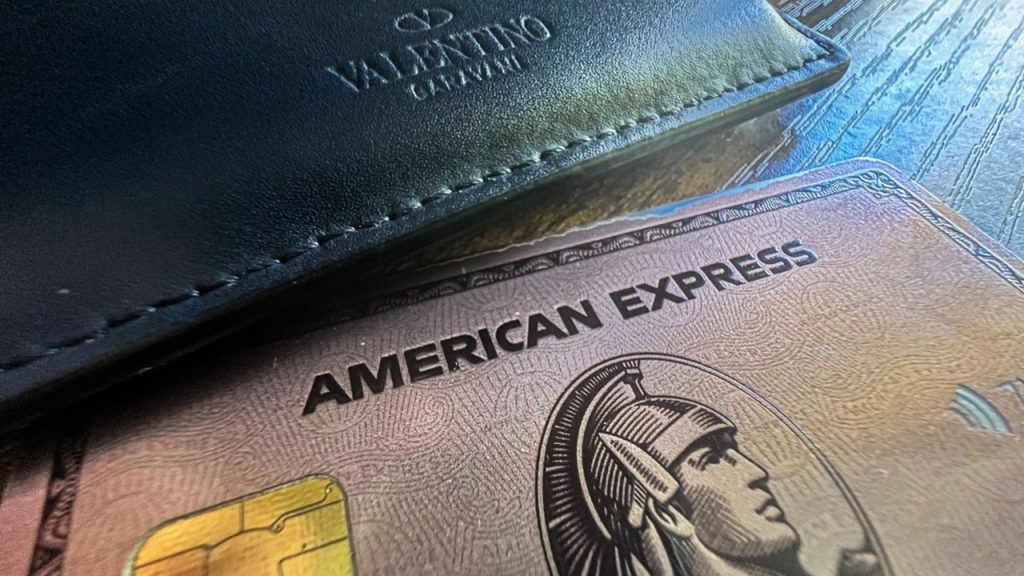An Amex card is a new Gen-Z status symbol. Just hop on TikTok, and you’ll see plenty of examples. College students flashing their Amex. People in their early 20s learning the powers (and dangers) of having no credit limit.
Young Americans seem to love its metal weight and the image of success Amex cards project. And it’s not an accident: the credit card company has worked hard to make it happen, tailoring its offers to Gen-Z (ages 18-27) and millennials (ages 28 to 43).
Amex cards can offer incredible value — to the right cardholder. That value, however, shouldn’t be measured by how “cool” it makes the cardholder look. Here’s more about Amex making their way into young people’s wallets and whether it truly belongs there. (Hint: it depends.)
An Amex card as a status symbol
Curious about the sentiment around Amex cards among Gen-Z and millennials, I went to the place I consider our natural habitat — TikTok. I typed “amex credit cards” into the search bar.
The results were illuminating. Young people indeed flock to Amex — sometimes to their detriment.
User @lifeofsky777 shares how she has both the American Express® Gold Card and The Platinum Card® from American Express as a college student.
@lifeofsky777 Replying to @Paige 💋 #finance #amex #creditcards #amexplatinum #finance #collegestudent ♬ Wii Party (Main Menu) – AxiomSeason
User @mattantunez shows what it’s like to have a no-limit credit card (Amex Gold) as a 23-year old. The video features shots from a shopping mall: an Apple store, Armani Exchange, Pacsun and other stores, followed by a trunk full of branded paper bags. I clutch my invisible pearls. The commenters share how they got the same card at 18 or 19 years old.
@mattantunez From hand me downs to being able to buy whatever I want at the mall. 💳🙏 #blessed #motivation #success #goals #grateful #gold #goldcard #amex #mall #clothes #shopping #foryou #money #store #public ♬ Like I Never Left – Kid Bloom
(The Amex Gold indeed has no preset limit. It has “purchasing power” — the amount you can spend that adjusts based on factors such as your credit, payment and purchase history.)
User @vedaclark posts about how shocked she was to learn at 19 years old that her Amex Platinum required the balance to be paid off every month. According to the video, her balance that month was $17,000.
@vedaclarki learned my lesson fair and square♬ original sound – kevmrtzz
(Note that the Amex Platinum isn’t technically a charge card. It’s true that it doesn’t have a preset limit — like the Amex Gold — but there’s a feature that allows you to split a purchase in several monthly payments called Plan It. Charge cards don’t provide such an option.)
I was bewildered. Spending choices aside, who wants to pay hundreds of dollars in annual fees so early in their credit journey? I had to remind myself people exist in different financial circumstances. I don’t know these folks, and none of them responded to my request for an interview. Maybe the fees are a drop in the bucket for them.
Or maybe not. If this is the content people see on the social media feeds, they might think this is normal. They might even think this is desirable. That having a premium Amex card says something about one’s social standing.
LaQueshia Clemons is a clinical social worker and an accredited financial counselor in the Greater Hartford area, Connecticut. She was inspired to pursue a career in financial therapy after racking up credit card debt at 18 years old – “just swiping away whatever I want.”
Clemons understands the appeal of an Amex card. “Sometimes, especially when you’re younger, you want to show off in front of your friends,” she says. “Let’s say you’re going out to a restaurant, and everyone’s splitting the check, and everyone’s pulling out their card. And your friends see [your Amex], and they’re like, ‘Oh, wow. You have an Amex. It’s a big deal. You must be making a lot of money.’”
I understand, too. I applied for the Amex Gold when I was younger. It made sense for me back then with how much I spent on food, especially delivery and takeout. While the decision to get the card was based on logic, I also remember how it felt to pay with it. So sleek, so heavy, so… rose gold. It made this Eastern European immigrant think about those American novels I read where rich people paid with an Amex. I felt like old money then while being perfectly middle class.
Perhaps, none of this is accidental. American Express, after all, is very much banking (pun intended) on younger generations liking it.
Amex wooes young cardholders
According to the issuer’s most recent earnings conference call, spending by millennials and Gen-Z makes up 33 percent of total spending on Amex cards — an impressive 13-percent growth year-over-year.
And it looks like this is what Amex has been counting on.
“We’ve leaned into millennials and Gen-Z,” Steve Squeri, American Express chairman and CEO, told Mad Money with Jim Cramer in April. “Millennials and Gen-Z make up a larger part of our business now.” Specifically, 60 percent of new Amex accounts were opened by millennials and Gen-Z.”
Jim Cramer, who’s 69 years old, noted how in his generation, when he got out of college, all he wanted was also an American Express card, which was hard to get.
“Now, it’s almost a necessity among young people,” he said in the interview. “How did you make it so that people feel, ‘without it, I can’t do what I want to do’?”
Squeri then explained that going after young people was key for Amex. A young cardholder’s lifetime value is “huge.” The issuer did its research and caught on to Gen-Z’s and millennials’ desire for experiences and special privileges. The Amex Gold and Platinum offer just that. And while those cards have high annual fees, the value they can offer is even higher.
And that’s how Amex goes after you. The company knows you like your travel, takeout and popular restaurants. It carefully tailored its offers to your wants. Its tagline “Don’t Live Life Without It” makes you feel like an Amex card is a necessity.
But is it? And is the value Amex offers the best you can get with a credit card?
Let’s dig into that.
Amex cards can offer hundreds of dollars in annual value
Amex doesn’t make false promises when it comes to the value of its cards. Indeed, Amex cards have the potential to provide excellent value, especially when it comes to premium cards.
For example, the Amex Gold charges a $325 annual fee, but it can offer more than $420 in recurring annual value through its statement credit benefits, including:
- Up to $84 in annual Dunkin’ credits (up to $7 per month, enrollment required)
- Up to $100 in annual Resy credits (up to $50 semi-annually, enrollment required)
- Up to $120 in dining credits at eligible restaurants and delivery services (up to $10 per month, enrollment required)
- Up to $120 annual credits for Uber Cash ($10 per month) toward Uber Eats orders or Uber rides in the U.S
Plus, the Amex Gold earns 4X points on restaurant purchases worldwide (on up to $50,000 in purchases per calendar year, then 1X points) and U.S. supermarket purchases (on up to $25,000 in purchases per calendar year, then 1X points), 3X points on flights booked directly with airlines or via Amex Travel and 2X points on prepaid hotels and other eligible purchases via Amex Travel. All other purchases earn 1X points.
The Amex Platinum charges a $695 annual fee and can provide around $1,700 in value every year. The card’s benefits include:
- $200 in annual airline fee credits
- $189 in annual CLEAR Plus membership statement credits
- Up to $100 credit for eligible The Hotel Collection bookings of two or more consecutive nights through American Express Travel
- Up to $200 in Uber Cash for rides or Uber Eats orders
- Up to $240 in digital entertainment credits annually
- Up to $300 in Equinox fitness membership credits per calendar year for eligible membership fees
- Up to $100 in annual Saks Fifth Avenue credits
- $155 annually in Walmart+ in monthly membership credits ($12.95, plus applicable taxes)
The Amex Platinum offers 5X points on prepaid hotels and flights booked directly with airlines or the American Express travel portal, 2X points on prepaid car rentals through the American Express Travel (up to $500,000 on these purchases per calendar year) and 1X points on all other purchases.
American Express Membership Rewards points are also valuable on their own. According to Bankrate valuations, they’re worth around 2 cents per point based on an average of the issuer’s five highest-value transfer partners. Without transferring, you can redeem your points for airfare at 1 cent per point at American Express Travel.
The value is only there for the right cardholder
Unless you’re a big spender, you’ll need to lean on the card’s annual credits to offset the high annual fee. If the benefits already fit your spending habits, this can be an easy task. If not, you might feel like you’re jumping through hoops to get the card’s promised value. And when you’re doing that just because you think your card says something about your social standing, it can become an issue for your financial well-being. Paying hundreds of dollars for projecting a certain image is a slippery slope.
Consider this: to offset the $325 annual fee on the Amex Gold with credits, you need to use both of the $120 credits and at least one other credit. If it doesn’t create new spending habits for you — as in, you already order food delivery regularly or use Uber — the card is a good fit. If not, you might start doing these things just to use the credits. This will create new expenses you haven’t had before.
You can also offset the annual fee by earning rewards. How much you need to earn depends on how you’re planning to redeem your Amex points. For instance, if you redeem for airfare through the issuer’s portal, you’ll need to spend $8,125 per year in the restaurant and U.S. supermarket categories to offset the annual fee.
As you can see, it takes some math and planning to figure out whether the Amex Gold is worth it for you. The math might be even more complex with the Amex Platinum. The annual fee is higher, and the annual credits are more niche. If you can’t use them to offset the fee, again, you’ll rely on rewards. This card offers bonus rewards only in travel categories, meaning your general purchases will yield a meager 1X points. You’d have to spend $69,500 per year with the card to fully offset the annual fee if you only earn rewards at the base rate and redeem for airfare through AmexTravel.
The alternative is to earn rewards on travel. That might not be an issue for a frequent traveler. But if you’re hoping to fund your trips exclusively with card rewards, the Amex Platinum might not be the best option.
“You have to remember your values”
Clemons compares having an Amex to driving a luxury car. Some people think the Tesla truck is a big deal because it’s expensive. Others drive the Mercedes Benz or the BMW to inform others of their status. Plenty of other people, however, realize none of that matters — although, this realization sometimes comes later in life.
That doesn’t have to mean saying no to credit cards — or even premium credit cards. But when you’re just beginning your credit journey, starting out with the Amex Platinum is like learning to swim in the middle of the ocean. While it storms.
For instance, if you want a solid travel card, look into the Capital One Venture Rewards Credit Card*. Don’t worry, it’s also a metal card, so it’ll give you the desired “plunk effect.” The card actually weighs more than the Amex Gold, according to The Points Guy. It also offers 5X miles on hotels and rental cars booked through Capital One Travel and 2X miles on all other purchases. The double rewards rate allows you to earn miles easily and quickly. Cardholders also get up to a $100 credit for Global Entry or TSA PreCheck and a $50 experience credit at hotels from the issuer’s Lifestyle Collection. The annual fee is $95.
Another low-maintenance metal travel card is the Chase Sapphire Preferred® Card. It earns 5X points on travel purchased through Chase Ultimate Rewards and Lyft Rides (Lyft offer through March 2025), 3X points on dining (including eligible delivery services), select streaming services and online grocery purchases (excluding Target, Walmart and wholesale clubs), 2X points on general travel and 1X points on everything else.
Cardholders also get $50 in annual statement credits for hotel stays booked through Chase Ultimate Rewards and an annual bonus equal to 10 percent of the total spent from the previous year. The Chase Sapphire Preferred charges a $95 annual fee.
These are only a couple of examples. The key is to find a credit card that matches your spending and goals without you needing to change your habits. For many, even a simple cash back credit card does the trick. TikTok might not think much of it, but most people do. You should earn hundreds of dollars in value on a credit card — not spend this money on a perceived status symbol. There are more affordable ways to appear chic.
“At the end of the day, you have to remember your values and what you want out of life. You’re the only person that should matter to yourself… who cares what everyone else has to say about it?”
— LaQueshia Clemons, clinical social worker and accredited financial counselor
The bottom line
Amex cards are desirable for a reason. It’s not just the company’s clever marketing. Many of the issuer’s products can indeed enhance your financial life. At the same time, if you have to add extra expenses to your budget to keep a credit card, it’s not likely to help you get ahead financially.
Carefully evaluate your spending habits before applying for an Amex card. Consider other options, too. After all, isn’t the ultimate coolness all about not caring what others think and doing what’s best for you?
*Information about the Capital One Venture Rewards Credit Card has been collected independently by Bankrate. The card details have not been reviewed or approved by the issuer.
Read the full article here










